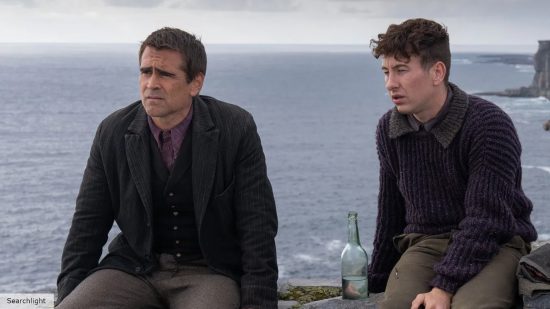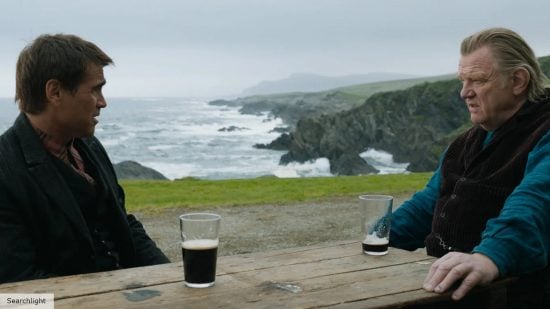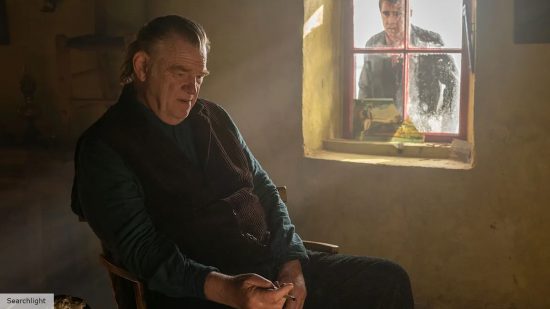Our Verdict
Colin Farrell shines in the riotously funny and achingly sad Banshees of Inisherin.
After unwisely travelling across the Atlantic for his last movie (Three Billboards Outside Ebbing, Missouri), Martin McDonagh has thankfully returned to where he is most comfortable – the land of his parents and clearly a source of endless love and fascination for him – Ireland.
He has also reteamed with the two main actors from his best movie so far – In Bruges’ Colin Farrell and Brendan Gleeson – and once again set them at each other’s throats. The Banshees of Inisherin is a continuation of some of the best of Irish literature, specifically the playwrights who have a uniquely distinctive grasp of humour that always has a dark undercurrent.
Death, grief, religion, futility, depression and existential themes are often bubbling under the surface of the most riotously funny works. There is certainly Samuel Beckett here and Brian Friel, as well as McDonagh’s own theatrical works – especially the Aran Islands Trilogy, which includes The Cripple of Inishmaan.
This comedy movie is set in 1923 on Inisherin, a fictional island off the coast of Ireland. The civil war between the Free State and the IRA rages on the mainland. Occasionally the sound of rifle and cannon fire can be heard, and the smell of smoke drifts over to peaceful, isolated Inisherin.
But war is about to erupt on the island, too, between best friends Colm (Gleeson) and Pádraic (Farrell). One day – seemingly without rhyme or reason – Colm tells Pádraic that he no longer wants to be friends and asks him not to speak to him anymore. This enrages the usually happy and ‘nice’ Pádraic, who cannot let it lie.
Pádraic is a simple fellow – he has a smallholding with three cows, a pony, and a beloved miniature donkey named Jenny. He lives with his sister Siobhan (Kerry Condon), who begrudgingly tolerates the animals, but her passions lie with books. Colm plays the fiddle, and his explanation for the abrupt end to the friendship is that he no longer has time for ‘dull chats’ because he needs to focus on writing a tune that will leave a legacy.

The island is populated by various eccentrics, including a harbinger/crone, an extremely nosy lady who works at the grocer/post office, and the landlord of the pub who tries to keep the peace. The island also has a policeman named Kearney, who represents some of the worst aspects of the mainland, and who has a son named Dominic (Barry Keoghan), who is even more simple than Pádraic.
Keoghan is one of the most exciting actors of his generation and worked with Farrell on The Killing of a Sacred Deer. He is an absolute highlight of The Banshees of Inisherin, consistently surprising with his line deliveries and physicality and just being unexpected at every turn.
The main conflict of the film is whether it’s enough to live a good but simple life, in which you’ve tried to be nice and kind to your fellow man, or whether you should strive to leave some kind of impression on the world. Colm is aware that his life is slipping away, and he doesn’t want it to all have been for nought.
Although it’s never mentioned, Colm’s cottage is full of wooden puppets and masks that he has clearly made himself. He is an artistic soul who has been gradually crushed by a lifetime of living on an island with people who lack curiosity and wonder. He is so determined for Pádraic to leave him alone that he threatens to cut his own finger off if he speaks to him again, which of course, will be detrimental to his fiddle-playing.
McDonagh deftly tows the lines between absurdity and outright hilarity to something much more heartfelt. Parts of the film are completely devastating, and Farrell is tremendous at conveying the comedy and tragedy of Pádraic’s situation.
Farrell has the most expressive eyebrows in the business, and he uses them to great effect here to express bafflement at Colm’s about-turn and sadness when everything he loves begins to leave him. Gleeson’s performance is still and even-tempered. Colm’s numbness, his ‘despair’ (which he discusses with the island priest in the confessional) seeps out of every pore. It is clear that Colm cannot do this anymore, and his drastic self-mutilation is the only way he can express it. He cuts off his nose to spite his face.
Condon also leaves an impression as Siobhan, who is completely exasperated by the increasingly demented behaviour of the men surrounding her. It is also patently obvious that she would have been better suited as a companion to Colm, but women are supposed to tend to the home and melt entirely into the background. On the few occasions when women appear in the pub, there is excitement. For however bad Colm thinks he has it, things are probably worse for them.
Ben Davis’ cinematography emphasises one of the other main conflicts of the film. Inisherin is a stunningly beautiful place to live. Colm resides in an almost comically stunning cliff-top cottage overlooking a wild beach. Pádraic spends his days gently encouraging his cows down lushly green country lanes, and his daily walk to the pub is the kind of experience that American tourists would pay handsomely for.
But is this enough? If you’re born and raised somewhere, it is hard to see its beauty. You’re more likely to focus on the fact that you know every single person on the island, they all know your business, and most of them rub you up the wrong way. Siobhan has been made aware from the books that she loves that she is living a small life with small people, and her brother’s bickering with his best friend probably puts this into sharp relief.
Frequent Coen Brother collaborator Carter Burwell’s score, combined with Gleeson’s own fiddle compositions, is another huge strength of The Banshees of Inisherin. The only time Colm looks at peace is when rubbing his dog’s ears or when a small group of music students play a reel in the pub.
This film is so distinctively Irish – the literary traditions that have informed it, the music that is Colm’s artistic expression, and the bleak but beautiful landscape. The dialect and turns of phrase also make this one of the funniest films in years.
The Banshees of Inisherin is a return to form for McDonagh after the gross misstep that was Three Billboards, and it is hoped that he’ll never leave the shores of Ireland again (unless it’s for an excursion to Belgium, of course). McDonagh has brought all of his experience as a playwright into this wonderful film, and it feels like a culmination of some of the best of Irish literature. Farrell, Gleeson, Condon, and especially Keoghan delight and surprise with their tender, achingly funny and sad performances. An invigorating, inspiring and impassioned work.


